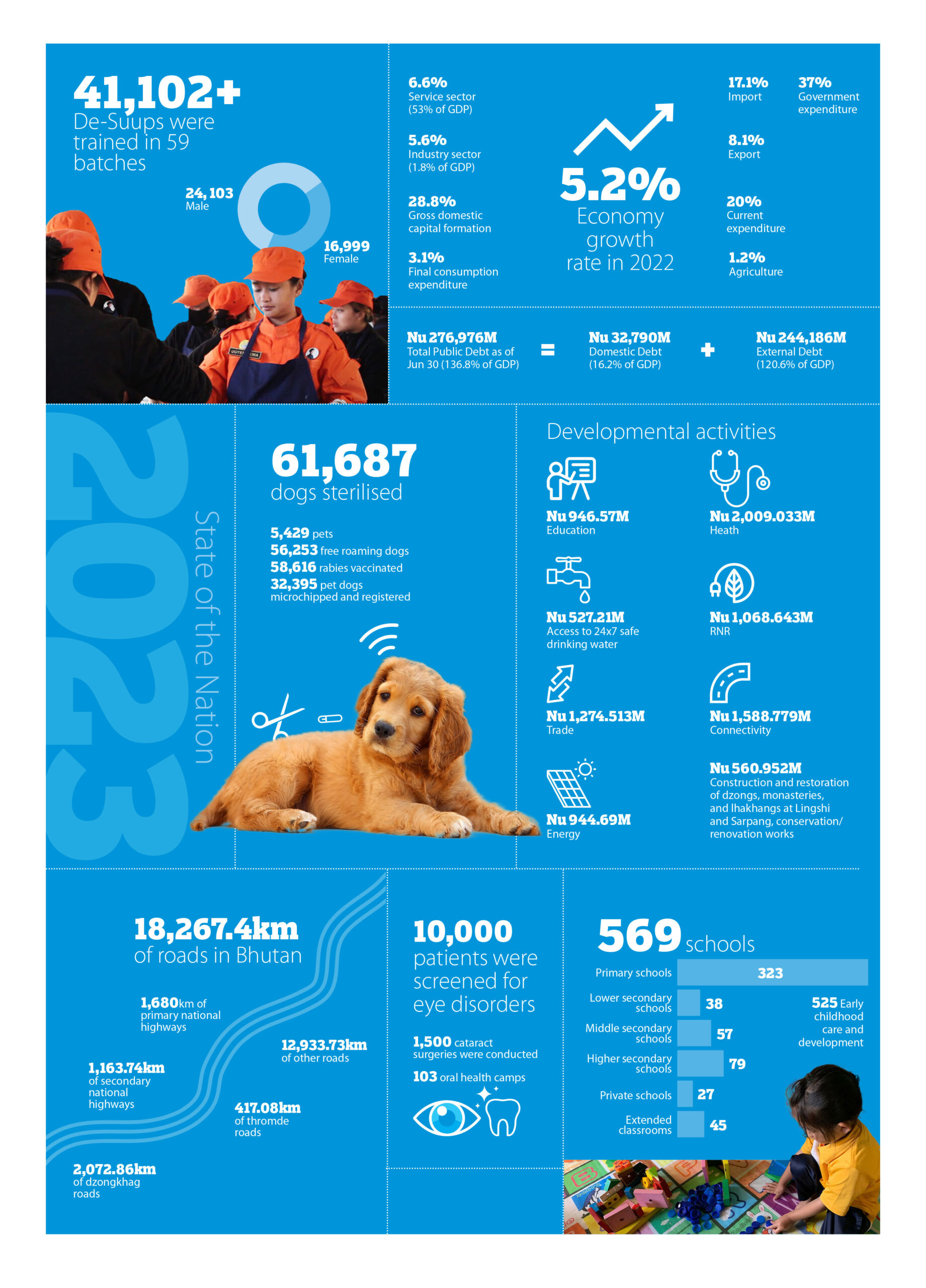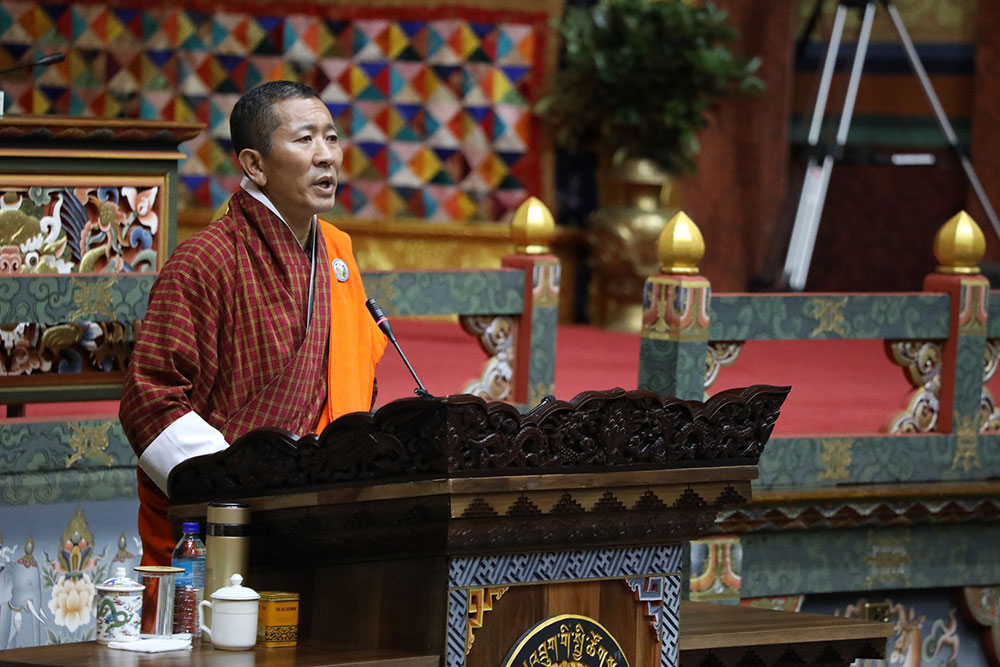… expresses gratitude for support in his State of the Nation report
Thukten Zangpo
Prime Minister Dr Lotay Tshering expressed gratitude for the remarkable contributions and achievements made by various sectors in his last State of the Nation report yesterday.
Reflecting the five years of government’s achievements, challenges, and plans, Lyonchhen acknowledged the efforts of His Majesty The King, Royal Family, government officials, security forces, and development partners.
Lyonchhen attributed the nation’s success in managing Covid-19 crisis to His Majesty The King’s able leadership.
He said that the government undertook various reforms and initiatives, emphasising national transformation. This included reforms in the mining sector, changes in the civil service system, and efforts to enhance accountability and productivity.
Lyonchhen also highlighted achievements in healthcare, mental health, education, and spirituality, the unity and resilience of the Bhutanese people.

Economy
In ensuring the businesses were running and cash was flowing in the economy, Lyonchhen said that 12th Plan’s actual expenditure was Nu 386 billion (B) against the initial budget outlay of Nu 310B, Nu 13B was spent for containing the pandemic.
As investments are required for value additions in the economy, he added that capital expenditure accounted for Nu 164B against the initial budget of Nu 116B in the 12th Plan.
While recurrent expenditure was at Nu 222B against initial allocation of Nu 194B for ensuring the functioning of government and uninterrupted service deliveries.
Despite the pandemic challenges, the country’s economy saw a recorded growth rate of 5.2 percent in 2022, marking a 14.4 percentage point jump from 2020.
The gross domestic product (GDP) per capita, which measures living standards, prosperity, and general welfare, increased to USD 3,833 in 2022, up from USD 3,660 in 2021, showing improved living standards.
The annual inflation stood at 5.6 percent in 2022, falling from 7.4 percent in 2021. As of July, this year, the price of goods and commodities increased by 4 percent compared to the same month last year.
In the last fiscal year 2022-23, the government mobilised a total resource of Nu 59.89B, an increase of 10 percent compared to the previous fiscal year. Domestic revenue realised at Nu 43.81B, contributed 73.1 percent and rest 26.9 percent from grants and other receipts.
For the current fiscal year 2023-24, the total resources are maintained at Nu 53.02 billion, a decrease of 11.5 percent compared to the last fiscal year. Domestic revenue is estimated at Nu 46.23 B and external grants at Nu 6.78B. While the total budget outlay for this fiscal year is Nu 74.6B , an increase of 7.6 percent compared to last fiscal year—Nu 45.55B as current and Nu 29.32B as capital.
The fiscal deficit of 7.9 percent of GDP in fiscal year 2022-23 is expected to grow to 9.9 percent of GDP (Nu 21.84B) in this fiscal year 2023-24, which would be financed through domestic and external concessional borrowings.
As of June, this year, the country’s debt stood at Nu 276.98B equivalent to 136.8 percent of GDP. Hydropower debt accounted for Nu 168.65B or 69.1 percent of total external debt.
Non-hydro debt was recorded at Nu 75.54B or 30.9 percent of total external debt. In coming years, the debt is expected to rise further because of hydropower disbursements, inclusion of upcoming several small hydropower plants, and budgetary borrowings to meet the resource gap.
With widening trade deficit, the current account balance is estimated to widen to 34.5 percent of GDP in fiscal year 2022-23 from 33.9 percent of GDP in the last fiscal year. Given the import of Nu 57.2B in the first six months this year, it is expected that the import value will reach Nu 113B this year.
Agriculture and forestry
One of the major achievements, Lyonchhen said, was the roll-out of chain-link fencing to address the human-wildlife conflict in fiscal year 2022-23.
The government allocated Nu 500M for one chain-link fencing per district. A total expenditure of Nu. 173.80M was made towards the construction spanning about 111.5 kilometers across the country. This resulted in the protection of over 3,000 acres of farmland benefiting 991 households.
The second phase of the million-fruit tree project started in February this year benefited more than 40,000 farmers.
At the same time, Omshari landmark irrigation project in Pemathang, Samdrupjongkhar built at a cost of Nu 95 million benefited 384 households after its completion in June this year.
Under the national accelerated dog population management programme, 61,687 dogs were sterilised, 58,616 rabies vaccinated, and 32, 395 pet dogs microchipped and registered.
In forestry, the sector has designated a total of 18 sites for collection of riverbed materials through dredging activities and is expected to generate about Nu 105 million in revenue over a lease period of three years.
Tourism
Between September 23 last year and October 1 this year, a total of 89,326 tourists arrived in the country. Of total, 61,162 were Indians and 28, 164 were other international guests.
In revenue, it contributed to USD 23.4M – sustainable development fee amounted to USD 19.7M from other countries and INR 3.06B from Indian tourists.
Hydropower
Lyonchhen expressed that Punatshachhu II will be operational by December 2024 and discussions are underway to move forward for Punatshangchhu I.
He added that three hydroprojects of Burgangchhu in Zhemgang, Yungichhu in Lhuentse, and Suchhu in Haa are well underway. At the same time, public consultations are complete and work awarding processes have begun for Jomori under Samdrup Jongkhar, Gamri I under Trashigang, and Druk Bindu under Samtse.
The work assessment for 1,125 mega-watt MW) Dorjilung will be complete by March 2024 and Kholongchu project will now be fully taken up by Druk Green Power Corporation.
Lyonchhen said that the Sephu solar project with a capacity of 17.38MW worth Nu USD 18.26M is being implemented along with smaller solar projects in Dechencholing and Pangbisa implemented in partnership with DeSuung.
Bhutan is also developing a national hydrogen roadmap and strategy to attract investments and diversify energy resources, including exploring the implementation of a 5MW hydrogen project.
Health
Recognising the rising cases of end stage renal diseases in the country and concerted efforts required to prevent premature deaths from it, Lyonchhen said the haemodialysis service was expanded in eight health facilities located strategically across the country.
The Jigme Dorji Wangchuck National Referral Hospital also launched the Living Donor Kidney Transplant Service and also established a Heart Centre on September 7.
Around 16,400 elderly were screened for non-communicable diseases and mental health disorders to address the increasing NCDs burden.
Radiology services (x-ray and ultrasound) expanded to 98 percent of hospitals (10 beds and above). CT scan services are available in all regional hospitals besides Samtse and Dewathang hospitals.
The construction of the 150-bed Gyaltsuen Jetsun Pema Wangchuck Mother and Child Hospital at the JDWNRH completed. The construction of the Pema Centre is projected to cost Nu 333.92M and is expected to complete by June 2026.
Education
Currently, Bhutan has a 64.9 percent adult literacy rate and a 97.7 percent youth literacy rate. From 2017 to 2022, the adult literacy rate increased by 5.2 percent.
There are 323 primary schools, 38 lower secondary schools, 57 middle secondary schools, 79 higher secondary schools, 27 private schools, 45 extended classrooms, and 525 early childhood care and development (ECCD) centres spread across the country.
These institutions collectively enroll 154, 140 students, which is about 20 percent of the population. Additionally, there are 10,158 teachers across 526 schools and 525 ECCD centres.
Likewise, there are nine vocational institutes with 3,065 students and 143 teachers, as well as 17 tertiary education institutes with 10,901 students and 788 teachers. The 132 new ECCD centres will begin operations this month employing 156 facilitators.
Private sector development
Lyonchhen said that the government will commit to consciously reduce the government’s role in economic activities and invite bigger and real private participation.
“We have started deregulation and we are exploring divestment. All government agencies have been directed to identify services that can be provided through private sector participation,” he said.
The government has established GovBiz Service Centre as the window to facilitate G2G, G2B, and G2C services. The centre will function as a comprehensive, one-stop- shop platform for all business- related services to the general public.
The government has endorsed trade and industry rules and regulations in August this year by simplifying licensing regimes and procedures and facilitating business for the growth of the private sector.
To address trade facilitation challenges, the construction of Pasakha, Gelephu, and Nganglam dry ports are on a completion rate of 50 percent, 35 percent, and 35 percent respectively as of June 30 this year.
The government has come up with Bhutan tradeFin net (BTFN) system, an online platform which facilitates cross border trade in terms of both goods and services.
CSI market was established outside Bhutan in USA and Australia at a cost of Nu 550M and a CSI market was also opened in Paro which promotes 300 plus CSI products targeting local and international tourists.
The government plans to increase the share of the manufacturing sector to GDP from 6 percent in 2021 to 15 percent by 2029, increase foreign direct investment from Nu 43.3B to Nu 100B by 2029.
Employment
National unemployment rate is estimated at 5.9 percent with a staggering 28.6 percent youth unemployment rate in 2022. The working age population was recorded at 484, 965 of which 305,983 persons were economically active.
In the last fiscal year 2022-23, 2,545 youth were engaged through youth engagement and livelihood programme; 2,063 youth placed through the overseas employment programme, and 8,892 job seekers were facilitated with direct job placements.
A total of 2,079 candidates underwent an entrepreneurship training programme. Business incubation centres catered to 12 incubates to date. In the fiscal year 2022-23, 37 new startups were established and 145 jobs created.
Infrastructure
The government constructed 2,500-bed quarantine centers – 500-bed each in Samtse, Amochhu, and Samdrupjongkhar, and 1,000-bed in Sarpang.
Flood protection works were carried out at Taraythang in Sarpang, Bondeyma in Mongar, and Pemathang in Samdrupjongkhar. Upgraded northern east-west highway, spanning from Thimphu to Trashigang with 489.33 kilometers in length.
Environment
Bhutan is establishing a carbon credit system under Article 6, Paris Agreement United Nations Framework Convention on Climate Change (UNFCCC) and national registry for trading emissions reductions.
At the same time, creating the Bhutan Climate Fund worth USD 50 million to monetise emission reductions, and setting up a climate museum to raise awareness and demonstrate Bhutan’s commitment to addressing climate change.
Culture
Drugyel Dzong reconstruction completed, Pemagatshel Druk Mijur Dechen Dzong was consecrated on September 22 and the restoration project of Kuenga Rabten Palace completed. The National Library and Archives in Thimphu established the Print Heritage Museum.
Good governance
The government approved eCommerce Policy, Public Debt Management Policy 2023, and HydroMet Policy of the Kingdom of Bhutan 2023.
There was approval of foreign workers as domestic helpers, revision of sustainable development fee (SDF) for non-tourists, SDF incentive, and implementation of foreign child caregivers.
The government made a substantial pay hike from 55 percent to 74 percent for civil servants from July this year.
From November last year, the childbirth benefit coverage was introduced where a lump sum amount of Nu 10,000 is provided to members for the birth of each child.
Mandatory annual leave provision of 21 days was also introduced as a measure to promote periodic rejuvenation and a healthier work-life balance for civil servants.


